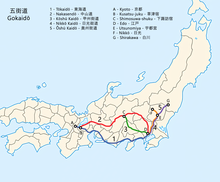
The Five Routes (五街道, Gokaidō), sometimes translated as "Five Highways", were the five centrally administered routes, or kaidō, that connected the de facto capital of Japan at Edo (now Tokyo) with the outer provinces during the Edo period (1603–1868).[1] The most important of the routes was the Tōkaidō, which linked Edo and Kyoto. Tokugawa Ieyasu started the construction of the five routes to increase his control over the country in 1601, but it was Tokugawa Ietsuna, the 4th shōgun of the Tokugawa shogunate and Ieyasu's great-grandson, who declared them as major routes. Post stations were set up along the route for travelers to rest and buy supplies.[1] The routes thrived due to the policy of sankin-kōtai, that required the daimyō (regional rulers) to travel in alternate years along the routes to Edo.[1]